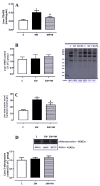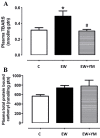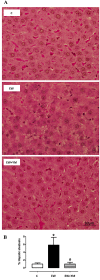Treatment with Ilex paraguariensis (yerba mate) aqueous solution prevents hepatic redox imbalance, elevated triglycerides, and microsteatosis in overweight adult rats that were precociously weaned - PubMed (original) (raw)
Treatment with Ilex paraguariensis (yerba mate) aqueous solution prevents hepatic redox imbalance, elevated triglycerides, and microsteatosis in overweight adult rats that were precociously weaned
E de Oliveira et al. Braz J Med Biol Res. 2018.
Abstract
Early weaning (EW) leads to overweight, visceral obesity, hyperleptinemia, and insulin resistance in adulthood. Treatment with Ilex paraguariensis (yerba mate) improves obesity and insulin resistance in these animals. Here, we evaluated the effects of chronic treatment with yerba mate on the redox balance and liver morphology of overweight early-weaned rats. To induce EW, we wrapped the dams with bandages to interrupt milk access during the last 3 days of lactation. Control pups (C) had free access to maternal milk for the full 21 days of lactation. On postnatal day (PN) 150, EW offspring were subdivided into the EW+YM group, which received the aqueous extract of yerba mate (1 g/kg bw by gavage once a day for 30 days) and the EW group, which received water by gavage for the same period. All rats were euthanized on PN180. The EW group showed higher bound carbonyl (a marker of total protein oxidation), higher TBARS levels (a marker of lipid peroxidation), and lower superoxide dismutase (SOD) activity in liver tissue than the C group, as well as higher triglyceride content and microsteatosis. In plasma, the EW offspring showed higher TBARS levels. One month of yerba mate treatment normalized these parameters. Thus, we have shown evidence that yerba mate improved antioxidant defenses and mitigated liver dysfunction in overweight adult rats that were weaned prematurely.
Figures
Figure 1.. Early weaning and yerba mate treatment did not change liver antioxidant enzymes content. A, superoxide dismutase 1 (SOD-1), B, superoxide dismutase 2 (SOD-2), C, glutathione peroxidase (GPx), and D, catalase protein content in the liver at postnatal day 180 of adult rats that were normally breastfed for 21 days (C), early weaned (EW), or EW that received yerba mate for 30 days (EW+YM). Data are reported as means±SE of 10 rats per group (ANOVA).
Figure 2.. Early weaning decreased superoxide dismutase (SOD) activity, and yerba mate treatment reduced catalase activity in the liver. A, SOD, B, glutathione peroxidase (GPx), and C, catalase activities in the liver at postnatal day 180 of adult rats that were normally breastfed for 21 days (C), early weaned (EW), or EW that received yerba mate for 30 days (EW+YM). Data are reported as means±SE of 10 rats per group. *P<0.05 vs C; #P<0.05 vs EW (ANOVA and Newman-Keuls multiple comparison test).
Figure 3.. Early weaning and yerba mate treatment did not alter plasma antioxidant enzymes activities. A, superoxide dismutase (SOD), B, glutathione peroxidase (GPx), and C, catalase activities in the plasma at postnatal day 180 of adult rats that were normally breastfed for 21 days (C), early weaned (EW), or EW that received yerba mate for 30 days (EW+YM). Data are reported as means±SE of 10 rats per group (ANOVA).
Figure 4.. Yerba mate treatment prevented the increase of thiobarbituric acid reactive substances (TBARS) and total protein bound carbonyl in the liver caused by early weaning. A, TBARS content, B, 4-hydroxynonenal (4HNE) protein adducts, C, total protein bound carbonyl, and D, 3-nitrotyrosine in the liver at postnatal day 180 of adult rats that were normally breastfed for 21 days (C), early weaned (EW), or EW that received yerba mate for 30 days (EW+YM). Data are reported as means± SE of 10 rats per group. *P<0.05 vs C; #P_<_0.05 vs EW (ANOVA and Newman-Keuls multiple comparison test).
Figure 5.. Yerba mate treatment prevented the increase of plasma thiobarbituric acid reactive substances (TBARS) levels caused by early weaning but early weaning and yerba mate treatment did not change plasma protein bound carbonyl. A, TBARS content and B, total protein bound carbonyl in the plasma at postnatal day 180 of adult rats that were normally breastfed for 21 days (C), early-weaned (EW), or EW that received yerba mate for 30 days (EW+YM). Data are reported as means±SE of 10 rats per group. *P<0.05 vs C; #P_<_0.05 vs EW (ANOVA and Newman-Keuls multiple comparison test).
Figure 6.. Yerba mate treatment prevented the increase of liver triglycerides induced by early weaning. Liver triglycerides content at postnatal day 180 of adult rats that were normally breastfed for 21 days (C), early weaned (EW), or EW that received yerba mate for 30 days (EW+YM). Data are reported as means±SE of 10 rats per group. *P<0.05 vs C; #P_<_0.05 vs EW (ANOVA and Newman-Keuls multiple comparison test).
Figure 7.. Yerba mate treatment prevented liver fat accumulation induced by early weaning. A, Photomicrographs of liver tissue stained with hematoxylin-eosin with same magnification (magnification 60×; bar: 30 μm). B, percentage steatosis at postnatal day 180 of adult rats that were normally breastfed for 21 days (C), early weaned (EW), or EW that received yerba mate for 30 days (EW+YM). The arrows indicate the droplets of lipids in the hepatocytes characterizing a microsteatosis. Data are reported as means±SE of 5 rats per group. *P<0.05 vs C; #P<0.05 vs EW (ANOVA and Newman-Keuls multiple comparison test).
Similar articles
- Ilex paraguariensis (yerba mate) improves endocrine and metabolic disorders in obese rats primed by early weaning.
Lima Nda S, Franco JG, Peixoto-Silva N, Maia LA, Kaezer A, Felzenszwalb I, de Oliveira E, de Moura EG, Lisboa PC. Lima Nda S, et al. Eur J Nutr. 2014 Feb;53(1):73-82. doi: 10.1007/s00394-013-0500-3. Epub 2013 Feb 9. Eur J Nutr. 2014. PMID: 23397595 - Effects of Ilex paraguariensis (yerba mate) treatment on leptin resistance and inflammatory parameters in obese rats primed by early weaning.
Lima Nda S, de Oliveira E, da Silva AP, Maia Lde A, de Moura EG, Lisboa PC. Lima Nda S, et al. Life Sci. 2014 Oct 12;115(1-2):29-35. doi: 10.1016/j.lfs.2014.09.003. Epub 2014 Sep 18. Life Sci. 2014. PMID: 25241125 - Effects of Ilex paraguariensis (yerba mate) on the hypothalamic signalling of insulin and leptin and liver dysfunction in adult rats overfed during lactation.
Conceição EP, Kaezer AR, Peixoto-Silva N, Felzenszwalb I, de Oliveira E, Moura EG, Lisboa PC. Conceição EP, et al. J Dev Orig Health Dis. 2017 Feb;8(1):123-132. doi: 10.1017/S2040174416000519. Epub 2016 Sep 9. J Dev Orig Health Dis. 2017. PMID: 27609670 - The positive effects of yerba maté (Ilex paraguariensis) in obesity.
Gambero A, Ribeiro ML. Gambero A, et al. Nutrients. 2015 Jan 22;7(2):730-50. doi: 10.3390/nu7020730. Nutrients. 2015. PMID: 25621503 Free PMC article. Review. - Yerba Mate Tea (Ilex paraguariensis): a comprehensive review on chemistry, health implications, and technological considerations.
Heck CI, de Mejia EG. Heck CI, et al. J Food Sci. 2007 Nov;72(9):R138-51. doi: 10.1111/j.1750-3841.2007.00535.x. J Food Sci. 2007. PMID: 18034743 Review.
Cited by
- The Effect of Ilex × meserveae S. Y. Hu Extract and Its Fractions on Renal Morphology in Rats Fed with Normal and High-Cholesterol Diet.
Kuropka P, Zwyrzykowska-Wodzińska A, Kupczyński R, Włodarczyk M, Szumny A, Nowaczyk RM. Kuropka P, et al. Foods. 2021 Apr 9;10(4):818. doi: 10.3390/foods10040818. Foods. 2021. PMID: 33918905 Free PMC article. - Health Benefits of Bioactive Compounds from the Genus Ilex, a Source of Traditional Caffeinated Beverages.
Gan RY, Zhang D, Wang M, Corke H. Gan RY, et al. Nutrients. 2018 Nov 5;10(11):1682. doi: 10.3390/nu10111682. Nutrients. 2018. PMID: 30400635 Free PMC article. Review.
References
MeSH terms
Substances
LinkOut - more resources
Full Text Sources
Other Literature Sources






